/cloudfront-eu-central-1.images.arcpublishing.com/prisa/TKMWZT53NJGG7MTPGDJGZFFAO4.JPG)
Medics on Ukraine’s front line: ‘It could be any one of us in their shoes. Everyone who comes to us is a hero’
EL PAÍS visits the network of medical stations that mark out the Zaporizhzhia front, where hundreds of wounded soldiers are operated on every day
Zaporizhzhia
As night falls on the Zaporizhzhia front, the roar of the movement of tanks in the dark intensifies in the rear. Their shadows can be glimpsed through the trees while, barely paying attention, several military doctors at a medical outpost are preparing to watch a movie while waiting for a battle in the form of bullets, shrapnel, amputations, and burns. They know that the patients will arrive sooner rather than later. That is why, when the play button is pressed, the glances between them take bets on the minute of the film when their next wounded comrade will arrive.
The headlights of a van announce the moment to hit pause. The new arrival has just been evacuated to this field hospital, one of many along the front lines of the Zaporizhzhia region and part of a mobile network of about a dozen that receive support from numerous smaller ones. “After a year and a half, I find it hard to say what I feel. I’ve got used to the blood, the wounds, the cut legs and hands... It’s a pity that this is happening to the kids who are defending Ukraine,” says Mikola, a 33-year-old health worker (like the rest of the interviewees, he does not provide his last name), after the reception of an amputee. Russia maintains control over 66% of Zaporizhzhia, one of the most active fronts of the ongoing Ukrainian counteroffensive.
The young man has been shot between his buttocks with the bullet exiting through his groin, leaving his pelvis broken. The surgeons start working at the same time as the anesthesiologists, who in a few minutes manage to calm him down and put him to sleep. A swarm of hands moves around the naked body, dotted with tattoos. The blood soakers are changed several times. After midnight, the operation is over and the X-ray results are available.
A wounded soldier arriving at a field hospital near the Zaporizhzhia front.LUIS DE VEGA
Over the course of three days, EL PAÍS visited almost a dozen field hospitals in southern Ukraine. The reporter is not authorized to state the location of the places he has been or to take photographs that could identify them. Some have been attacked on several occasions. One was bombed for the 10th time two days after this newspaper’s visit. There were no casualties, but it served as a reminder that the enemy lurks nearby. The authorities in Kyiv do not provide casualty statistics at the field hospitals.
Before the day has even begun, a relief team is in place. Dawn is an hour of intense activity, they warn. Tania is a 38-year-old operating room nurse who has been under the umbrella of the Ukrainian Army since the Russian invasion began. She left behind a husband and two children. She says with a smile that she will soon be a grandmother. “The hardest thing is to be so close to the pain,” she admits. She is part of the improvised morning get-together with other health workers, seated on the wheelchairs used to transport patients. At that moment, an SUV bursts in at full speed.
A soldier who was screaming in pain was pulled out of the vehicle, squeezing his eyelids tightly shut and contracting the muscles in his face. He had fallen victim to one of the greatest dangers posed by the Russians in the counteroffensive: mines. Advancing with his comrades through a field, he stepped on one and lost his left foot. The remains of part of his boot and foot are still hanging from his leg, leaving a trail of blood all the way to the operating room.
Within seconds, two surgeons are already working on the carnage. They do so illuminated by LED lights that allow them to clean, cut, suture and sew the leg. Up to a dozen people move amid the controlled chaos of the operating room, the windows of which are protected by sandbags.
A medic shows a bullet removed from the arm of a wounded soldier.LUIS DE VEGA
Outside, Mikola removes the amputee’s belongings and documentation from his uniform. Before throwing away the useless garments, he rips off the velcro and pulls off the emblem of the brigade to which he belongs to give it back to the wounded man. He then proceeds to hose down the blood trail and the stretcher before it coagulates.
“It could be any one of us in their shoes. Everyone who comes to us is a hero,” says Mikola. He immediately goes on to prepare the next raffia sack with the patient’s number written in black marker where his belongings are placed. A white board on the door of the makeshift hospital marks the number of patients for the day. There are days in these frontline hospitals when there are well over 100. Many of them are considered red patients; the most serious cases, above green (mild) and yellow (medium).
Vadim, a 30-year-old psychologist in charge of one of the medical posts on the Zaporizhzhia front, explains that he has not been to his home town for a year and a half. As if on a sightseeing tour, he shows the three operating rooms and two ICU beds set up in a former kindergarten. “We get 60 to 100 casualties a day here, of which 10% to 15% are reds. This is a quiet place,” he says. Next to him, one of his men sports an arm-length tattoo with a message in Latin: Si vis pacem, para bellum (if you want peace, prepare for war).
A soldier wounded by a land mine is operated on.LUIS DE VEGA
The medical structure in this region is based on four levels, explains Eugene, 41, who ran a private clinic before the war and is now in charge of another of these military hospitals. First there are the combat medics, those who are at the front with their comrades; then there are outposts like the ones he runs, known as FST (Forward Surgical Team); a third level is occupied by the hospitals in Zaporizhzhia and, lastly, the large hospital in Dnipro, the fourth-most populated city in the country.
Sometimes they get a few minutes’ notice. “Two green and one yellow in 15 minutes,” the walkie-talkie alerts them. On other occasions, the engine of a van or a car pulling in announces, on the fly, that there’s trouble. There may be a trickle of casualties with small intervals in between, or a flurry of vehicles with many at the same time. The objective of the FST, Eugene explains, is to stabilize, operate and evacuate to the third level at Zaporizhzhia as soon as possible, in order to ensure beds and operating rooms remain available. The pace of vehicles and ambulances arriving from the front is almost the same as those transferring wounded soldiers to the regional capital.
A group of health workers awaits the arrival of soldiers wounded at the front.LUIS DE VEGA
The background noise is a reminder that some of the Ukrainian Army’s positions are not far away. Neither are the targets the Russians are trying to hit. Oleksi, 40, the head of combat medics in a brigade, arrives from the front. “The most complicated thing,” he says, “is to organize evacuations among so many minefields, because they have to be done quickly and on foot.”
“Sometimes it takes up to six hours for them to get to us,” Eugene laments after supervising the operation on the amputee who arrived in the morning. “This one has arrived here after only an hour and a half. In Kherson the Russians didn’t have as much time to plant mines,” he notes. Eugene took a break from running his clinic between 2014 and 2015 to join the army in the war against the Donbas separatists, which has been rocking eastern Ukraine for nine years. “I have been out of surgery since 2015. It’s impossible to be both a surgeon and a hospital chief,” he says. The military team he now heads, the vast majority of whom were civilian personnel until early 2022, spent a month-long training period under NATO standards in Estonia.

At around 10 a.m., several vehicles arrive with wounded. Almost all of them are in shock and with severe burns, including to the head and face. The medical personnel remain calm. In a few minutes, some are already covered with scar tissue, bandaged like mummies and with the shrapnel removed. To do this, the medics unhesitatingly insert their fingers through the wounds and punctures. When they take out the pieces of metal, they offer them to the soldiers as souvenirs. It’s not yet midday and about 40 patients have already arrived. “It’s an easy, quiet day,” says Eugene in the midst of the hustle and bustle.
A while later, some of the soldiers who arrived with burns are already waiting at the back of the field hospital to be evacuated to Zaporizhzhia. A table made of pallet wood is set up for them, offering water, coffee, sweets, and cigarettes. In a ghostly-looking meeting in which they are grateful to be alive, several of them recount that they were in an armored vehicle when a Russian anti-tank missile hit them “full on.”
One of the soldiers, Iurii, 30, helps one of his comrades to drink water through a small hole that allows him to stick his tongue and lips out between the bandages. He lights a cigarette, takes out his cell phone and starts looking at photos that he shows to the reporter: “Look, this is my daughter Natacha, seven years old. And my wife is pregnant.”
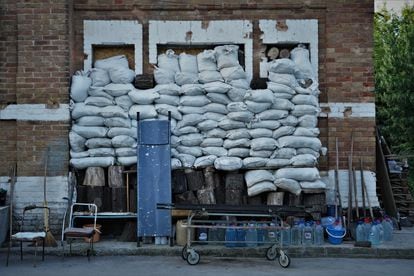 Sandbags protect one of the hospitals on the front line, which are sometimes targeted by Russian shells.LUIS DE VEGA
Sandbags protect one of the hospitals on the front line, which are sometimes targeted by Russian shells.LUIS DE VEGAEL PAÍS

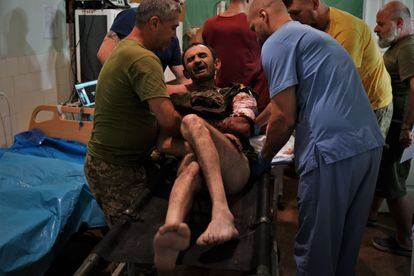
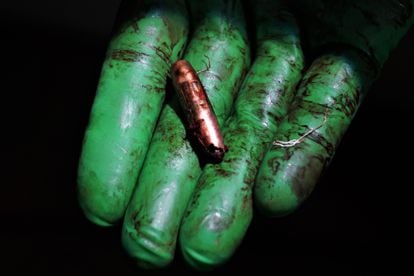
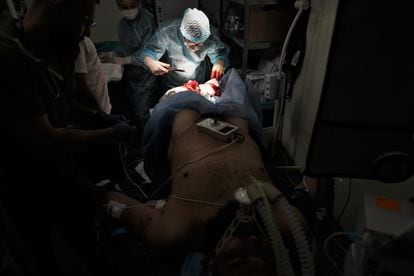
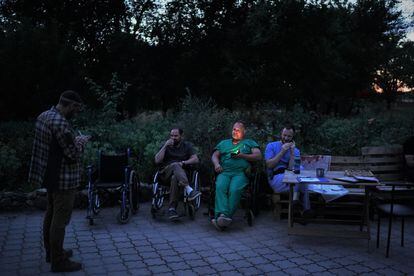

No comments:
Post a Comment